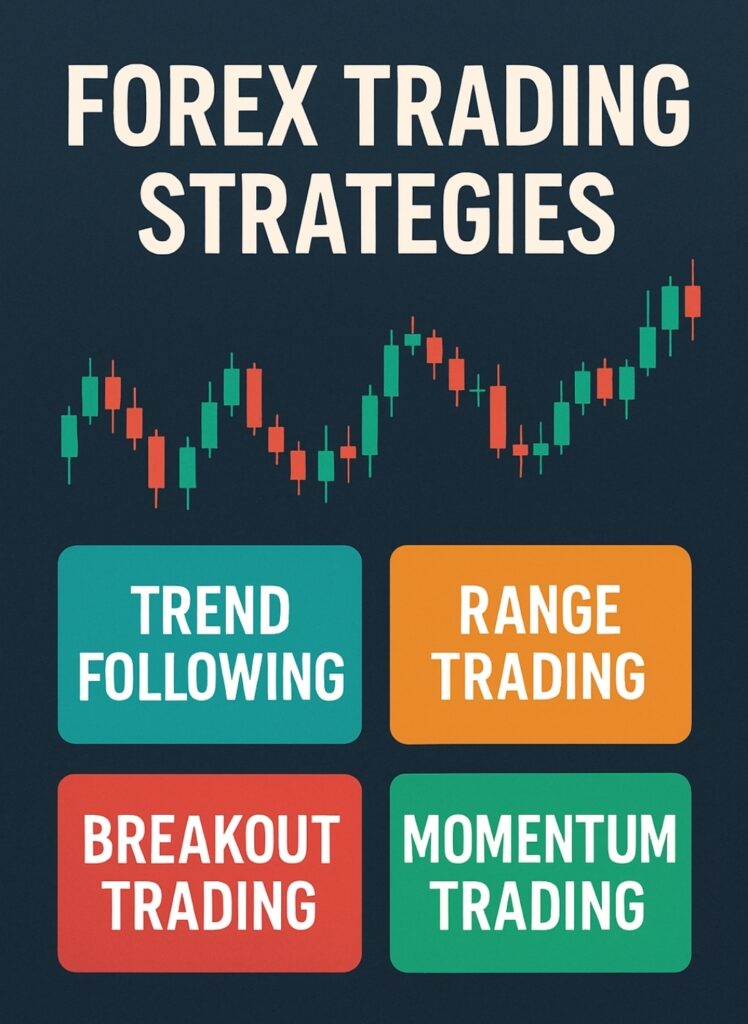Forex Trading Strategies – Complete Guide
Successful forex trading requires a solid understanding of various strategies tailored to different market conditions. This comprehensive guide explores the most effective forex trading strategies used by professionals, explaining how they work and when to apply them for optimal results in various market environments.
Most Popular Forex Trading Strategies
Price Action Trading
Analyzing raw price movements without indicators to make trading decisions. This strategy focuses on identifying patterns, support/resistance levels, and candlestick formations to predict future price movements.
Swing Trading
Holding positions for several days to capture short-to-medium-term market moves. Swing traders use technical analysis to identify potential price swings and aim to profit from both upward and downward trends.
Day Trading
Opening and closing positions within the same trading day to avoid overnight risk. Day traders capitalize on small price movements using high leverage and focus on liquid currency pairs during peak hours.
Scalping
Making numerous trades throughout the day to profit from very small price changes. Scalpers hold positions for seconds to minutes and rely on tight spreads, high liquidity, and quick execution.
Position Trading
Long-term strategy where trades are held for weeks, months, or even years. Position traders focus on fundamental analysis and major economic trends rather than short-term market fluctuations.
Carry Trade
Borrowing a currency with a low interest rate to buy a currency with a higher interest rate. Traders profit from the interest rate differential while hoping for minimal exchange rate fluctuation.
Breakout Trading
Entering positions when price moves outside a defined support or resistance level with increased volume. Breakout traders aim to capture the momentum that follows the突破 of key price levels.
Trend Following
Identifying and trading in the direction of established market trends using indicators like moving averages. This strategy assumes that prices that have been trending will continue to trend until reversal signals appear.
Range Trading
Identifying currency pairs that are moving between specific high and low levels and trading the bounces. Range traders buy near support levels and sell near resistance levels in sideways markets.
Strategy Comparison Table
| Strategy | Timeframe | Risk Level | Best Market Condition |
|---|---|---|---|
| Scalping | 1-15 minutes | High | High volatility |
| Day Trading | 15 mins – 4 hours | Medium-High | Moderate volatility |
| Swing Trading | 1 day – 1 week | Medium | Trending markets |
| Position Trading | Weeks – Months | Low-Medium | Strong fundamentals |
| Carry Trade | Months – Years | Low | Low volatility |
Timeframe-Specific Strategies
Short-Term Strategies (M1 – H1)
Short-term strategies focus on capturing small price movements using technical indicators like RSI, stochastic oscillators, and moving average crossovers. These approaches require constant market monitoring and quick decision-making, making them suitable for traders who can dedicate time during trading sessions.
Medium-Term Strategies (H4 – D1)
Medium-term strategies combine technical and fundamental analysis to capture trends that develop over several days or weeks. These approaches typically use Fibonacci retracements, MACD, and support/resistance levels to identify entry and exit points with favorable risk-reward ratios.
Long-Term Strategies (W1 – MN)
Long-term strategies primarily rely on fundamental analysis, including interest rate differentials, economic growth projections, and geopolitical factors. Position traders using these strategies often employ wider stop-losses and focus on major currency pairs with strong fundamental trends.
Risk Management in Forex Trading
Regardless of strategy, effective risk management is crucial for long-term success. Always risk only 1-2% of your account per trade, use stop-loss orders religiously, and maintain a favorable risk-reward ratio of at least 1:2. Diversify your portfolio across different currency pairs and strategies to minimize exposure to any single market movement.
Mastering forex trading requires understanding various strategies and knowing when to apply them based on market conditions. The most successful traders combine multiple approaches, adapt to changing markets, and maintain strict risk management protocols. Remember that no strategy works perfectly in all conditions, so continuous learning and practice are essential for long-term profitability in the forex market.





